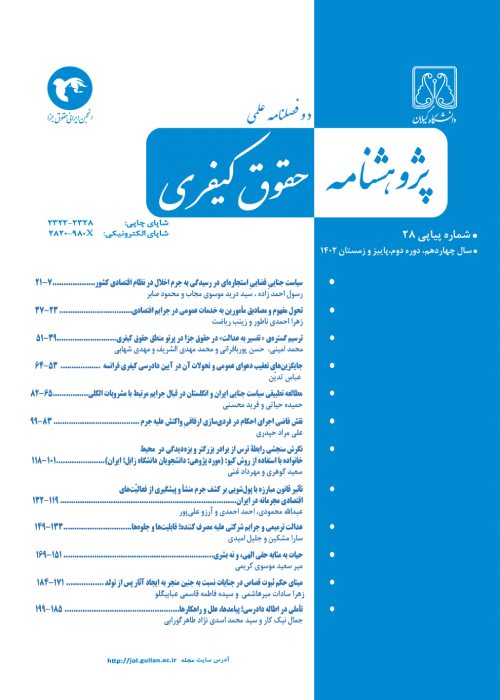Procedural and substantive challenges of sentencing in property destruction(Emphasizing the law on reducing the imprisonment)
The Law on Reducing the Imprisonment, , considers the punishment of destruction of property, is considered a subordinate of the amount of damages caused by the crime, and thus poses numerous challenges to the judicial authorities.This research examines the issue with a descriptive-analytical method and identifies the most important challenges in "time and quantitative indicator of determining the amount of damage", "determining the degree of crime and consequently determining the competent authority and appropriate surveillance","determining the punishment of a single perpetrator", determining the punishment of "multiple perpetrators" and the "determination of the punishment of multiple destructions" and then, with a scientific-practical approach, it is approved that the amount of damage caused at the time of destruction should be determined first by the victim's estimation and preferably by providing evidence and discretion of the judicial authority continue to refer to an expert if necessary. Also, in case of occurrence of crime and when the damage extent is not known, a fine equal to one Rial of fine shall be imposed and in the case of accomplices of the crime, each accomplice and in the material multiplicity of the crime, the damage of each property should be calculated separately.
Although the law on reducing the punishment of imprisonment has been passed with less scientific and theoretical goals, With functionalist and managerial approaches in order to reduce the prison population, nevertheless, in some of its regulations, it has made fundamental changes in criminal law. One of them is the change that has taken place in the way the punishment for "destruction of property" is determined; A change of scope, which in turn leads to a change in the criminal investigation process.
With the change in the type and amount of punishment for the crime of destruction of property according to the law reducing the punishment of imprisonment, the judicial system has faced several challenges in dealing with this crime. These challenges include how the judge determines the amount of damages and the final sentence. To overcome these challenges in the short term, the present study has collected and analyzed a set of different perspectives and then with a descriptive-analytical method examines the most important challenges and by considering the principles of criminal law, it has provided the most appropriate and practical solutions.
Article 677 of the fifth book of the Islamic Penal Code (Tazirat) provides the six months to three years of imprisonment for the perpetrator of destruction. In this article, the legislator had explicitly determined the type and amount of punishment and required the judge to determine the punishment by establishing the occurrence of the crime and attributing it to the accused, regardless of other components. With the occurrence of this crime, proving that the plaintiff had a financial right and its violation by the defendant was sufficient for trial and sentencing. After that, in 2020, the Law on Reducing the Punishment of Imprisonment in Paragraph "T" of Article 1 stipulated that the punishment of imprisonment subject to Article 677, if the amount of damage is one hundred million Rials or less, becomes a fine of up to twice the amount of the damage. As a result of this change, both the type and the amount of punishment for the crime of destruction are subject to an important factor, namely the amount of damage: Thus, if the amount of damage is more than one hundred million Rials, the type of punishment for this crime is imprisonment. However, if the damage is one hundred million Rials or less, this crime is no longer subject to imprisonment and the type of punishment is a fine. But the amount of the fine also depends on determining the exact amount of damage. Obviously, it will not be possible to determine the type and amount of punishment for this crime without determining the total amount of damage (more or less than one hundred million Rials) or its exact amount. The legislator's new method of determining the type and amount of punishment creates challenges for the pre-trial and sentencing stages, as well as the principle of determining the degree of the crime.
To overcome the existing challenges in determining the degree of crime of destruction, we have proposed that among the indicators of determining the degree of crime based on the amount of damage, determining the degree of crime based on the sentence in Note 3 of Article 19 and determining the degree based on the criteria adopted from the 759 Procedural unity vote, the latter case, should be used for more compatibility with legal principles. In the face of the challenge of determining the time index of the amount of damage, the time of committing the crime should be the criterion instead of the time of trial and issuance of the verdict. Finally, instead of being assessed by the injured party or referred to an expert, the recognition of the authority should be used as a more accurate solution in the short term for the prosecution of this crime. In the long term, the legislature must create a judicial unity to end these ambiguities to prevent the formation of conflicting interpretations. In the next step, it should review the regulation and reduce the criminal population of the prison as a goal in other ways, such as reducing the amount of imprisonment without any dependence on the amount of damages or giving more power to the court to convert or reduce imprisonment or using non-civic indicators.
- حق عضویت دریافتی صرف حمایت از نشریات عضو و نگهداری، تکمیل و توسعه مگیران میشود.
- پرداخت حق اشتراک و دانلود مقالات اجازه بازنشر آن در سایر رسانههای چاپی و دیجیتال را به کاربر نمیدهد.


